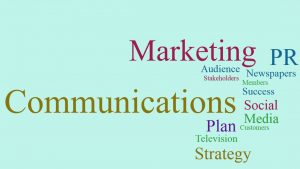Seldom a week goes by that someone doesn’t ask me to explain the difference between marketing, communications, and public relations. Plenty of business people confuse and intermingle these terms. This confusion can lead to problems moving your products and/or promoting your business or organization.
It’s important to know: Marketing is not communications and communications is not marketing. Since marketing, communications and PR are related fields that rely on one another for success, it’s easy to think you’re doing one well when perhaps you are not.

Business strategies defined
In simple terms, marketing is a strategy that encompasses all the ways
a business or organization serves its customers. Renowned marketing professor E. Jerome McCarthy once described this strategy as The Marketing Mix, which includes the four Ps: product, pricing, place and promotion. Under McCarthy’s model, marketing strategy could include everything from product development plans to selecting point-of-sales locations to selling products.
Communications planning and execution certainly should be a component of that marketing strategy. It involves identifying key audiences, which in most cases will include customers and stakeholders, and targeting relevant messages to them. Communications also includes choosing the right medium (ads, newsletters, social media, websites, etc.) to deliver your message and developing a plan for when and how to share information. Good communications should help build your brand and support your sales team.
Finally, public relations, like advertising, is one of the options organizations and businesses have to communicate with current and potential customers. PR strategies focus on maintaining a positive image and often rely on communicating though earned media such as newspapers, television news, blogs, etc. PR often is a cost-effective way to gain attention, credibility, and ultimately leads or sales. However, PR is most effective when it is part of a broader communications and marketing plan.
Ask yourself: Who am I?
An important point for business and organizational leaders to understand is that there is no one-size-fits-all strategy for marketing or communications. To do either effectively, you must know who you are, what you have to offer, and who you are trying to reach.
Once you have these answers, you can start developing a strategic marketing and communications plan that will help you succeed.
As a colleague recently described it to one of our potential clients, “Our experience is that a thoughtful, sharply developed approach to specific audiences is far more effective than a broad and general communication that may not have a strong connection to the services you provide.”
I couldn’t have said it better myself.
Ed Green
C2 Senior Strategist




